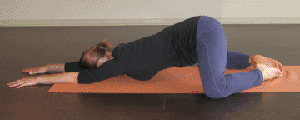Old habits die hard. It's that time of the year again - finals. This basically equates to my sitting in a chair for hours on end with my head leaning forward and downward into a book. And how 'bout that stress? Doesn't help with my head woes to say the least. This seems like a recipe for disaster and a return to my old, forward head ways.
But I am determined to break this habit! Here are a few exercises that I do at my desk to combat the tension that builds in my neck and upper back.
Bear Hug Stretch
In this exercise, I wrap my arms around my shoulders and give myself a bear hug stretch. It's simple to do and effective; I feel a release in my shoulder blades, my natural neck curve returns (even if just for a moment), and I feel my neck elongating.
Steps to Bear Hug Stretch
1) Any stretch that I do is basically with the purpose of elongating my left side. With my right hand, I reach around the left side of my body to hold onto my shoulder blade (much easier than it sounds). With my right hand still in place, I take my left hand OVER my right arm and hold on to my right shoulder blade with my left hand. It should look something like this:
So, for left curving scoliosis, left arm over right.
2) Now for the good part! With your shoulders resting back against a chair for support (and to make sure you don't cheat to one side!) slowly raise the elbows up and toward your nose. You should naturally feel the urge to raise your head, so go ahead and raise your head ever-so-slightly. Just remember to always keep space between your chin and your elbows or else you may end up crunching up your neck and not get the full neck elongation effect of the stretch. To make sure that my shoulders are even, I like to gently press my middle finger around the shoulder blade to keep my hand and shoulder blade connection secure.
3) At this point, your elbows should be a bit higher than shoulder height with your head slightly raised so that your eyes are looking slightly above the level where your monitor (or book) is located. Maintaining this position, slightly arch the back - SLIGHTLY! When I arch, I usually feel a good release around my cervical neck area and around my right shoulder blade. Be sure that both feet are evenly planted on the floor throughout the entire exercise.
Remain in this slight arch, elbows up position for a few breaths. For an even deeper stretch, I sometimes gently turn my head to the right while in my elbows up, slight arch.
This exercise takes a whole of 15 seconds to do but works wonders for relieving built up tension from hours of study. I try and do it at least every 30 minutes of desk time. Experiment with different hand-to-shoulder blade positions to stretech different parts of your upper back.
Knee-to-Desk Exercise
This exercise sounds a little unusual for a work-related exercise, but it's discreet and I find that it stretches my lower back, an area that is typically tight in scoliosis sufferers.
Steps to Knee-to-Desk
1) Put your butt all the way in the back of the chair and keep your back pressed against the seat back of your chair. This creates a nice firm base of support. I like to hold onto my arm rests to feel balanced during the exercise.
2) Place both feet flat on the floor about hip width apart at 90 degree angles with the toes slightly pointed toward each other (make yourself slightly pigeon toed for this exercise).
3) Making sure to keep your butt and back pressed against the seat back of your chair, slowly raise one knee and touch the underside of your desk. Slowly return your foot to the floor. Keep the foot in the same exact pigeon toed position during the up and down movement. Repeat on the other side.
You should be working your deep abdominals to do this exercise. If you feel the work in your thigh (quadricep), reposition your feet on the floor to turn in your toes a little more (pigeon toed) or even bringing the knees together. This makes the exercise a little more difficult and also ensures that you can't cheat quite as easily. Also, be sure not to lean from side to side when you alternate lifting legs. If you're doing that, then you're not allowing your core to do the work. If the Knee-to-Desk movement is tough to start with, make it smaller (bring your knee up only a little) until you can work up to touching the desk.
This exercise stretches my lower back and I can feel it all the way up through my shoulder blade. I've seen a lot of desk leg lift exercises where the leg is lifted straight out. Although I think that movement would certainly be better than nothing, I find that starting with this smaller, more targeted movement helps my body learn how to control itself better at the core and allow me a more significant stretch.
Elbows on Desk Stretch
I know, I know, you shouldn't have your elbows on a table... not to mention, chronically keeping your elbows elevated will probably worsen neck tightening. But if I do this movement in a targeted way, I find the stretch relieving to my shoulder blade tension.
Steps to Elbows on Desk Stretch:
1) Put your butt all the way in the back your chair, creating a firm base of support.
2) I like to clasp my hands in a easy prayer hold (usually with my left thumb on top).
3) Put elbows on top of your desk with the hands lightly clapsed together. Your hands will be around eye level.
4) Slowly roll your chair backward with your feet, creating an easy, gentle arch in your back. If your chair doesn't roll, then pre-place your chair however far away from your desk as you'd like before you begin the stretch.
5) While in your gentle arch, slightly raise your chin so that you are gazing directly above the hands.
For a deeper stretch, bring the elbows closer together atop your desk.
It should look sort of like this (with you seated of course and not on your knees - feel free to try on your knees though if no one is watching!):
This streth releases my lower back as well as my shoulders and feels oh-so-nice.
Try these 3 exercises as often as you can to release tension in the upper back and neck.
Happy desking!










































